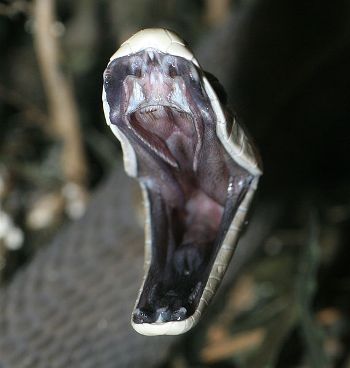Interactions
Within its habitat, the Black Mamba is described as a nervous snake. Black Mambas share their habitat with lions, wildebeests, zebra, rhinoceros, cheetah, leopard and the African elephant. The Black Mamba exhibits a predatory relationship with other organisms and is considered to be a tertiary consumer as it consumes secondary consumers. Black Mambas typically hunt smaller prey; these include smaller birds, bush babies, rodents, bats and sometimes other snakes. Furthermore, Black Mambas kill their prey by squeezing its victim to death or by injecting its lethal venom.
Black Mambas typically have a deadly affect on organisms that interfere with its territory. The Black Mamba is labeled as very aggressive and is sometimes described as the world’s most aggressive snake according to snake experts. When confronted, the Black Mamba will not hesitate to defend its territory and will prepare for an attack.
The demeanor of the Black Mamba correlates with its body temperature and results in two different responses when threatened by another organism. With a cooler body temperature, the Black Mamba will generally stay in one spot, however, it will lift its head and front third of its body and prepare for an attack. With a flattened neck, the mamba will open its mouth and release a resonating hiss. Moreover, if the Black Mamba is continually confronted it will then repeatedly strike back. With a warmer body temperature, the Black Mamba will move forward and begin to raise its upper third of its body (about four feet high) and will repeatedly strike back without interrupting its forward movement. After its initial attack, the Black Mamba will cease its striking pose and deliver a long muffled hiss. Any movement followed by this initial attack will only encourage the mamba to strike again. Additionally, the Black Mamba rarely delivers a dry bite while defending its territory.
Black Mambas are infamous for their lethal venom that contains both neurotoxins and cardiotoxins. Unfortunately, humans are vulnerable to these toxins released by the Black Mamba. On average, a single bite delivers about 100-120 mg of venom. If the snakebite goes untreated, the victim will typically have twenty minutes before the neurotoxins play their deadly role on the nervous and cardiac systems, resulting in death. In addition, Dendroaspis polylepis produce a specific neurotoxin known as dendrotoxins, which act as a convulsant. This is done by the excessive release of neurotransmitters at neuromuscular junctions resulting in the blockage of potassium channels causing the body to convulse uncontrollably. Furthermore, a single bite from a Black Mamba can have enough venom to kill anywhere from twenty to forty grown men (14). Symptoms associated with the mamba’s snakebite include tingling sensations in the extremities, drooping eyelids, tunnel vision, sweating, excessive salivation and the lack of muscle control. If the bite goes untreated, the victim will experience nausea, shortness of breath, confusion, paralysis and death all in a matter of twenty minutes. Before the discovery of anti-venom, the bite from a Black Mamba was 100% fatal. For more information on how to treat a snakebite from a Black Mamba click here.
Although the Black Mamba’s venom is fatal if untreated, scientists have recently discovered two unknown pain-reducing peptides found within the mamba venom. These peptides were given the name mambalgins. Previous research shows that toxins found within the venom bind to proteins called ASICs embedded in nerve cells resulting in pain. ASICs are commonly associated with playing a central role in how our body responds to a painful stimulus. Although previous research on snake venom focused on the activation of ASICs, recent research on lab mice showed that mambalgins act as pain inhibitors. Further research has revealed similarities between mambalgins and opiates. Although there is more research to be done on mambalgins, the future of medicine may be looking at a new painkiller.
Click here to go to Home page

